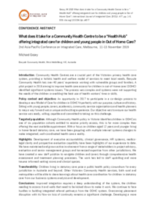Abstract
INTRODUCTION
Community Health Centres are a crucial part of the Victorian primary health care system, providing a holistic health and welfare model of services to meet local needs. Banyule Community Health has over 40 years’ experience working with vulnerable groups and families. A pilot project in 2016 aiming to improve health care access for children in out-of-home care (OOHC) identified significant systems issues. The process was complex and systems were not supporting the needs of the children or enabling the best use of health workers’ time or skills.
POLICY CONTEXT AND OBJECTIVE
An opportunity in 2017 to participate in a co-design process to develop a new Model of Care for children in OOHC fit perfectly with our purpose, culture and history. Sitting with young people, carers, academics, community service organisations and health planners to map a way forward was a unique and exciting experience. Our objective was to ensure our health service was ready, willing, capable and committed to taking on this challenge.
TARGETED POPULATION
Although Community Health policy in Victoria identifies children in OOHC as one of six population cohorts entitled to receive priority access, this is far more complex than offering the next available appointment. With a focus on children aged 12 years and younger living in home-based statutory care, we have been grappling with multiple internal systems changes to make integrated, well-coordinated health care a reality.
HIGHLIGHTS
Development of executive accountability, clinical governance, HR systems, medico-legal clarity and prospective evaluation capability have been highlights of our experience to date. We have maintained and grown active involvement from a range of stakeholders in project advisory, evaluation and senior management groups and harnessed expertise from other jurisdictions. We have created a new staff position to navigate children and carers through comprehensive health assessment and treatment planning processes. The work has led to staff upskilling and more trauma informed waiting rooms and clinical spaces.
TRANSFERABILITY
Children living in statutory care pose a public health policy conundrum for every jurisdiction in Australia and beyond. Other Victorian Community Health services, both rural and metropolitan will be able to share learnings about health care coordination for children in statutory care from our business systems analysis and development.
CONCLUSIONS
Improved integration requires a deep understanding of the system, the children needing to access it and walls that need to be kicked down to make it work. We continue to face hurdles in building integrated referral pathways from the OOHC system. Overcoming placement disruption with its flow-on loss of continuity remains a significant challenge. Developing a more evidence-based understanding of case complexity and the implications for our health workforce is a constant focus.
Our work is demonstrating that strong executive leadership, area-based collaboration and long-term vision are essential to integrated responses. Integration requires deep thinking and planning, understanding of trauma and the lived experience of children in care and committed purpose-driven practitioners. Children in out of home care deserve a red carpet service – this is our challenge.

